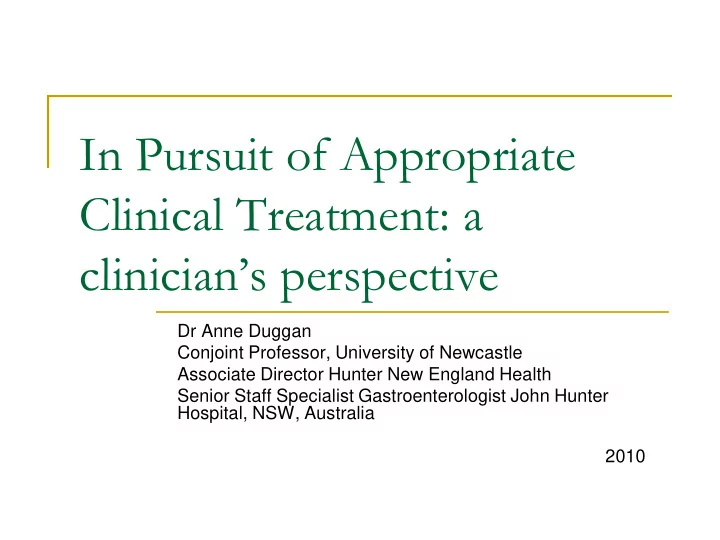

In Pursuit of Appropriate Clinical Treatment: a clinician’s perspective Dr Anne Duggan Conjoint Professor, University of Newcastle Associate Director Hunter New England Health Senior Staff Specialist Gastroenterologist John Hunter Hospital, NSW, Australia 2010
Clinical Appropriateness Unwarranted variation contributes substantially to healthcare costs Controllable aspects relate to: Procedure Proceduralist Place Patient Opportunities exist to decrease cost and improve quality
Clinical Appropriateness
Clinical Appropriateness “The Dartmouth experience” ….. Fisher et al, Annals Int Med, 2003
Clinical Appropriateness “The Dartmouth experience” ….. Fisher et al, Annals Int Med, 2003
Clinical Appropriateness “The Dartmouth experience” ….. Fisher et al, Annals Int Med, 2003
Clinical Appropriateness Procedure Proceduralist Place Patient
Clinical Appropriateness Even inexpensive tests can have expensive outcomes Faecal occult blood tests (FOBT) Medicare Benefit Schedule fee $9.05 Study of outcome of tests on 330 patients in one of 3 hospitals Only 1 patient had an appropriate indication for testing 50% presented with bleeding symptoms 18% problem warranted investigation irrespective of the outcome of FOBT Use and abuse of faecal occult blood tests (FOBT) in an acute hospital inpatient setting Friedman, A. et al. IMJ 2010
Clinical Appropriateness Even inexpensive tests can have expensive outcomes 1 in 6 patients adversely affected as a result of testing patients inappropriately subjected to colonoscopy patients were not referred for colonoscopy because they returned a negative FOBT Delayed subsequent treatment Inappropriate subsequent treatment Increased inpatient stay
Clinical Appropriateness Gastroscopy Gold stand for Barrett’s surveillance = 1. Gastroscopy with 4 quadrant biopsies/cm length of Barrett’s + 2. Repeat gastroscopy at recommended intervals Over 2000 Barrett’s surveillance cases in a U.S. community Linked gastroscopy and pathology reports 51% adherence to guidelines Longer segment associated with reduced adherence (> 9cm Odds Ratio = 0.03) Non-adherence had a lower pre-malignant detection rate (OR 0.53)
Clinical Appropriateness Key Components Procedure Proceduralist Place (Environment) Patient
Clinical Appropriateness Quality of care Fisher et al, Annals Int Med, 2003
Clinical Appropriateness Procedure Proceduralist Place Patient
Clinical Appropriateness Complexity…
Clinical Appropriateness Complexity… Cumulative Percent Survival of Primary Hip Replacement Partial vs Total Hazard Ratio (95%Confidence Interval) 0 ‐ 3Mth: HR=10.77 (10.07, 11.51) p<0.001 3Mth ‐ 6Mth: HR=6.97 6Mth ‐ 1.5Yr: HR=5.15 1.5Yr ‐ 2.5Yr: HR=4.03 2.5Yr ‐ 3.5Yr: HR=3.69 3.5Yr ‐ 4Yr: HR=3.52 4Yr ‐ 5Yr: HR=3.38 Would physician involvement improve outcomes (clinical and financial)? Australian Orthopaedic Association National Joint Replacement Registry Mortality following Primary Hip and Knee Replacement 2010 REPORT
The way forward…
Evidence Based Best Practice Guidelines and Standards… Application of NHMRC guidelines to colonoscopic surveillance Bamford P. MJA 2002; 176: 155-157 Postpolypectomy surveillance decisions matching the guidelines increased from 37% to 96% ( P < 0.05) 23% reduction in colonoscopies performed per year Mean time to repeat colonoscopy after polypectomy increased from 2.7 to 3.5 years ( P < 0.005) 17% reduction in colonoscopies performed on the basis of a family history of colorectal cancer
Credentialling…
Clinical Leadership… Gawande, The New Yorker, 2009
Team development … Mortality Index (n hospitals) Sophistication of training policy - 0.31 p< 0.05 Level of teamwork - 0.37 p< 0.05 Use of staff appraisal - 0.34 p< 0.05 61 acute hospitals in UK: 2000-7,500 employees Case severity adjusted (West et al 2002)
Checklists …
Clinical Appropriateness The informed and informing patient… Early Palliative Care for Patients with Metastatic Non– Small-Cell Lung Cancer N Engl J Med 2010;363:733-42. Conclusions Among patients with metastatic non–small-cell lung cancer, early palliative care led to significant improvements in both quality of life and mood. As compared with patients receiving standard care, patients receiving early palliative care had less aggressive care at the end of life but longer survival.
Opportunities Incorporate quality indicators into negotiations with private hospitals Link with professional bodies interested in pursuing professional standards such as credentialing Share public sector safety agendas such as Time Out, hand hygiene, medication safety, open disclosure with stakeholders Align with other health related groups interested in quality e.g. ACI, CEC, ACHS Promote patient education Train patients to drive agenda e.g. advance care directives; Joint Commission Promote Clinical Leaders to drive change
Questions
Recommend
More recommend